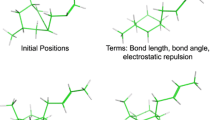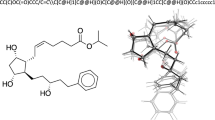Abstract
To test and validate the Automated force field Topology Builder and Repository (ATB; http://compbio.biosci.uq.edu.au/atb/) the hydration free enthalpies for a set of 214 drug-like molecules, including 47 molecules that form part of the SAMPL4 challenge have been estimated using thermodynamic integration and compared to experiment. The calculations were performed using a fully automated protocol that incorporated a dynamic analysis of the convergence and integration error in the selection of intermediate points. The system has been designed and implemented such that hydration free enthalpies can be obtained without manual intervention following the submission of a molecule to the ATB. The overall average unsigned error (AUE) using ATB 2.0 topologies for the complete set of 214 molecules was 6.7 kJ/mol and for molecules within the SAMPL4 7.5 kJ/mol. The root mean square error (RMSE) was 9.5 and 10.0 kJ/mol respectively. However, for molecules containing functional groups that form part of the main GROMOS force field the AUE was 3.4 kJ/mol and the RMSE was 4.0 kJ/mol. This suggests it will be possible to further refine the parameters provided by the ATB based on hydration free enthalpies.



Similar content being viewed by others
References
Verlinde CLMJ, Hol WGJ (1994) Structure-based drug design: progress, results and challenges. Structure 2(7):577–587
Tollenaere JP (1996) The role of structure-based ligand design and molecular modelling in drug discovery. Pharm World Sci 18(2):56–62
Ooms F (2000) Molecular modeling and computer aided drug design. Examples of their applications in medicinal chemistry. Curr Med Chem 7(2):141–158
Wang J, Wang W, Kollman PA, Case DA (2006) Automatic atom type and bond type perception in molecular mechanical calculations. J Mol Graphics Model 25(2):247–260
Wang J, Wolf RM, Caldwell JW, Kollman PA, Case DA (2004) Development and testing of a general amber force field. J Comput Chem 25(9):1157–1174
Krieger E, Koraimann G, Vriend G (2002) Increasing the precision of comparative models with YASARA NOVA—a self-parameterizing force field. Proteins 47(3):393–402
Zoete V, Cuendet MA, Grosdidier A, Michielin O (2011) SwissParam: a fast force field generation tool for small organic molecules. J Comput Chem 32(11):2359–2368
Patel S, Brooks CL 3rd (2004) CHARMM fluctuating charge force field for proteins: I parameterization and application to bulk organic liquid simulations. J Comput Chem 25(1):1–15
Patel S, Mackerell AD Jr, Brooks CL 3rd (2004) CHARMM fluctuating charge force field for proteins: II protein/solvent properties from molecular dynamics simulations using a nonadditive electrostatic model. J Comput Chem 25(12):1504–1514
Berendsen HJC, van der Spoel D, van Drunen R (1995) GROMACS: a message-passing parallel molecular dynamics implementation. Comp Phys Comm 91(1–3):43–56
van der Spoel D, Lindahl E, Hess B, Groenhof G, Mark AE, Berendsen HJC (2005) GROMACS: fast, flexible, and free. J Comput Chem 26(16):1701–1718
Halgren TA (1996) Merck molecular force field. I. Basis, form, scope, parameterization, and performance of MMFF94. J Comput Chem 17(5–6):490–519
Halgren TA (1996) Merck molecular force field. II. MMFF94 van der Waals and electrostatic parameters for intermolecular interactions. J Comput Chem 17(5–6):520–552
Halgren TA (1999) MMFF VII. Characterization of MMFF94, MMFF94 s, and other widely available force fields for conformational energies and for intermolecular-interaction energies and geometries. J Comput Chem 20(7):730–748
Vanommeslaeghe K, Hatcher E, Acharya C, Kundu S, Zhong S, Shim J, Darian E, Guvench O, Lopes P, Vorobyov I, Mackerell AD (2010) CHARMM general force field: a force field for drug-like molecules compatible with the CHARMM all-atom additive biological force fields. J Comput Chem 31(4):671–690
Vanommeslaeghe K, MacKerell AD (2012) Automation of the CHARMM general force field (CGenFF) I: bond perception and atom typing. J Chem Inf Model 52(12):3144–3154
Vanommeslaeghe K, Raman EP, MacKerell AD (2012) Automation of the CHARMM general force field (CGenFF) II: assignment of bonded parameters and partial atomic charges. J Chem Inf Model 52(12):3155–3168
Malde AK, Zuo L, Breeze M, Stroet M, Poger D, Nair PC, Oostenbrink C, Mark AE (2011) An Automated Force Field Topology Builder (ATB) and Repository: version 1.0. J Chem Theory Comput 7(12):4026–4037
Oostenbrink C, Villa A, Mark AE, van Gunsteren WF (2004) A biomolecular force field based on the free enthalpy of hydration and solvation: the GROMOS force-field parameter sets 53A5 and 53A6. J Comput Chem 25(13):1656–1676
Berman HM, Westbrook J, Feng Z, Gilliland G, Bhat TN, Weissig H, Shindyalov IN, Bourne PE (2000) The protein data bank. Nucleic Acids Res 28(1):235–242
Dewar MJS, Zoebisch EG, Healy EF, Stewart JJP (1985) Development and use of quantum mechanical molecular models. 76. AM1: a new general purpose quantum mechanical molecular model. J Am Chem Soc 107(13):3902–3909
Stewart JJP (1989) Optimization of parameters for semiempirical methods I. Method. J Comput Chem 10(2):209–220
Stewart JJP (1989) Optimization of parameters for semiempirical methods II. Applications. J Comput Chem 10(2):221–264
Becke AD (1993) Density-functional thermochemistry. III. The role of exact exchange. J Chem Phys 98(7):5648–5652
Lee C, Yang W, Parr RG (1988) Development of the Colle-Salvetti correlation-energy formula into a functional of the electron density. Phys Rev B 37(2):785–789
Perdew JP, Wang Y (1992) Accurate and simple analytic representation of the electron-gas correlation energy. Phys Rev B 45(23):13244–13249
Schmidt MW, Baldridge KK, Boatz JA, Elbert ST, Gordon MS, Jensen JH, Koseki S, Matsunaga N, Nguyen KA, Su S, Windus TL, Dupuis M, Montgomery JA (1993) General atomic and molecular electronic structure system. J Comput Chem 14(11):1347–1363
Singh UC, Kollman PA (1984) An approach to computing electrostatic charges for molecules. J Comput Chem 5(2):129–145
Canzar S, El-Kebir M, Pool R, Elbassioni K, Malde AK, Mark AE, Geerke DP, Stougie L, Klau GW (2013) Charge group partitioning in biomolecular simulation. J Comput Biol 20(3):188–198
Berendsen HJC, Postma JPM, van Gunsteren WF, Hermans J (1981) Interaction models for water in relation to protein hydration. In: Pullman B (ed) Intermolecular forces. Springer, The Netherlands, pp 331–342
van Gunsteren WF, Weiner PK, Wilkinson T, Wilkinson AJ (1997) Computer simulation of biomolecular systems: theoretical and experimental applications. Springer, Leiden
Beutler TC, Mark AE, van Schaik RC, Gerber PR, van Gunsteren WF (1994) Avoiding singularities and numerical instabilities in free energy calculations based on molecular simulations. Chem Phys Lett 222(6):529–539
Zacharias M, Straatsma TP, McCammon JA (1994) Separation-shifted scaling, a new scaling method for Lennard-Jones interactions in thermodynamic integration. J Chem Phys 100(12):9025–9031
Allen P, Tildesley DJ (1989) Computer simulation of liquids. Oxford University Press Inc, New York
Schmid N, Christ CD, Christen M, Eichenberger AP, van Gunsteren WF (2012) Architecture, implementation and parallelisation of the GROMOS software for biomolecular simulation. Comput Phys Commun 183(4):890–903
Ryckaert J-P, Ciccotti G, Berendsen HJC (1977) Numerical integration of the Cartesian equations of motion of a system with constraints: molecular dynamics of n-alkanes. J Comput Phys 23(3):327–341
Berendsen HJC, Postma JPM, van Gunsteren WF, DiNola A, Haak JR (1984) Molecular dynamics with coupling to an external bath. J Chem Phys 81(8):3684–3690
Heinz TN, van Gunsteren WF, Hünenberger PH (2001) Comparison of four methods to compute the dielectric permittivity of liquids from molecular dynamics simulations. J Chem Phys 115(3):1125–1136
Geballe MT, Skillman AG, Nicholls A, Guthrie JP, Taylor PJ (2010) The SAMPL2 blind prediction challenge: introduction and overview. J Comput-Aided Mol Des 24(4):259–279
Guthrie JP (2009) A blind challenge for computational solvation free energies: introduction and overview. J Phys Chem B 113(14):4501–4507
Nicholls A, Mobley DL, Guthrie JP, Chodera JD, Bayly CI, Cooper MD, Pande VS (2008) Predicting small-molecule solvation free energies: an informal blind test for computational chemistry. J Med Chem 51(4):769–779
Acknowledgments
The development of the ATB has been supported by the Australian Research Council (ARC; Grant No.: DP0987043, ARC DP110100327, ARC DP130102153) AKM acknowledges the award of an Australian Post-Doctoral (APD) fellowship. KBK acknowledges the award of the University of Queensland International Scholarship (UQI). Computational resources were provided by the National Computational Infrastructure (NCI, Australia) National Facility (projects m72 and n63). Support from the Queensland Cyber Infrastructure Foundation and NeCTAR is gratefully acknowledged. The authors also wish to thank W. Chen, M. El-Kebir, G. Klau and D. Warne for assistance in the development of the ATB version 2.0 and associated infrastructure.
Author information
Authors and Affiliations
Corresponding author
Additional information
Katarzyna B. Koziara and Martin Stroet have contributed equally to the work.
Electronic supplementary material
Below is the link to the electronic supplementary material.
Rights and permissions
About this article
Cite this article
Koziara, K.B., Stroet, M., Malde, A.K. et al. Testing and validation of the Automated Topology Builder (ATB) version 2.0: prediction of hydration free enthalpies. J Comput Aided Mol Des 28, 221–233 (2014). https://doi.org/10.1007/s10822-014-9713-7
Received:
Accepted:
Published:
Issue Date:
DOI: https://doi.org/10.1007/s10822-014-9713-7




